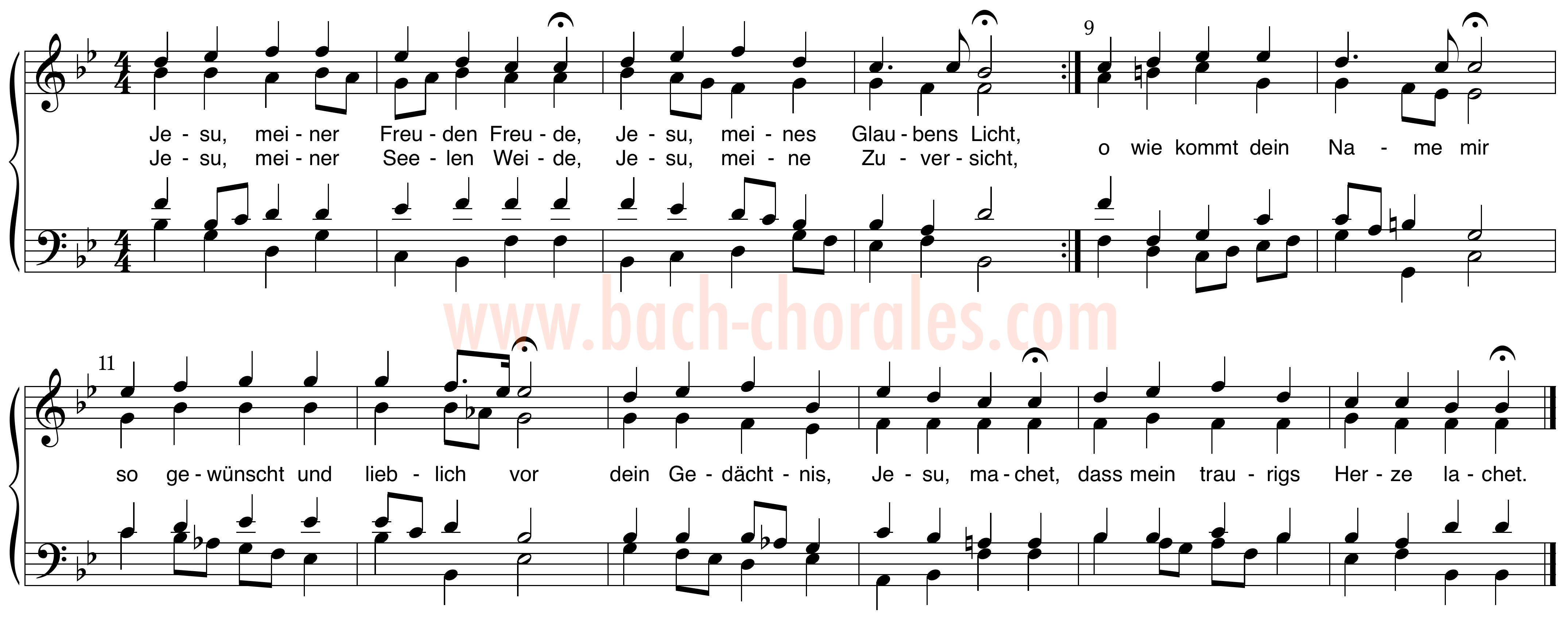 |





|
BWV 360

Previous: BWV 359
Next: BWV 361
Original source: Chorale, Jesu, meiner Seelen Wonne, BWV 360
Chorale Text: Jesu, meiner Seelen Wonne*, by Martin Jahn (1661)
Tune: Werde munter mein Gemüte, by Johann Schop (1642) (Zahn 6551)
First Performance: Unknown
Appearance in Early Collections (Key):
Riemenschneider 350;
Breitkopf 349;
Dietel 104;
AmB 46II p.307
Other Harmonizations: BWVs
55.5,
146.8,
147.6=147.10,
154.3,
244.40,
359
Notes
This chorale survives without text. The text that appears here is the one provided by editors of the Bach Gesellschaft Ausgabe (BGA).
Speculation regarding liturgical occasion: According to Häfner, this setting (or BWV 359) possibly served as the closing chorale for the lost cantata Ich scheue mich, gerechter Gott for the 11th Sunday after Trinity in the Picander–Jahrgang (Picander 54), with the 6th verse of Werde munter, mein Gemüte by Johann Rist. (See NBA III/2.1 KB, p.82 or III/2.2 KB, p.319; for BWV 359 see III/2.2 KB, p.328.) Arguably, the inclusion of BWV 360 in the Dietel collection and absence of BWV 359 from the same may lend slightly more support for the former. (—LD)
However, also worth noting is that the this portion of the Dietel collection falls (very) roughly according to the liturgical calendar in such a way to suggest that BWV 360 may have been from a lost cantata for Cantate (4th Sunday after Easter) or thereabouts.
Dietel 101 (BWV 112.5) = for Misericordias Domini, 2nd Sunday after Easter
Dietel 102 (BWV 103.6) = for Jubilate, 3rd Sunday after Easter
Dietel 103 (BWV 100.6) = for a wedding(?)
Dietel 104 (BWV 360) = ??
Dietel 105 (BWV 87.7) = for Rogate, 5th Sunday after Easter
Dietel 107 (BWV 43.11) = for Ascension
Dietel 108 (BWV 44.7) = for Exaudi
View a complete listing of speculations regarding the liturgical occasions of individual BWV 253–438 chorales.
"Cadential Fifths:" The Dietel version of this chorale features parallel fifths in measure 12. In the Dietel, the soprano’s dotted rhythm on beat 2 is presented in straight eighth notes creating parallel fifths with the alto’s Bb–Ab figure. Such "cadential parallels," which are considered non–structural since they involve non–chord tones, can be found in several chorales, most notably in BWV 40.8 where four instances occur. The fact that editors of the Breitkopf edition and other early chorale collections took liberties in "correcting" such parallel fifths suggests that the Dietel version of this chorale (or at least this particular cadence) may be authentic and the Breitkopf version (presented here) may represent a modification by an editor. For a complete account of consecutive fifths and octaves in the Bach chorales, see "Consecutive Fifths & Octaves in the Bach Chorales" featured on the Articles & Research page.
bach–chorales.com by Luke Dahn. Copyright 2018.